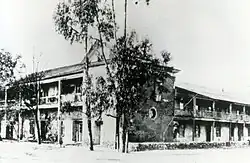| Salvador Vallejo Adobe | |
|---|---|
 Salvador Vallejo Adobe | |
| Type | House |
| Location | Sonoma County |
| Coordinates | 38°17′36.3″N 122°27′32.12″W / 38.293417°N 122.4589222°W |
| Built | 1836[1][2] |
| Built for | Salvador Vallejo María de Carrillo Vallejo |
| Official name | Salvador Vallejo Adobe[3] |
| Designated | December 16, 1952[3] |
| Reference no. | 501[3] |
 Location of Salvador Vallejo Adobe in California  Salvador Vallejo Adobe (the United States) | |
The Salvador Vallejo Adobe is a historic building located in Sonoma, California in the United States. The building is a California Historic Landmark.
History
The home was originally built by "Indian laborers" for Salvador and María de Carrillo Vallejo.[4][5] The home was built circa 1836.[1][2] Carrillo Vallejo decorated interior with imported furniture, embroidery (made by Indian servants[2]), engravings, and Catholic art. Edwin Bryant described the parlor as being decorated with "handsome chairs, sofas, mirrors and tables of mahogany frame work and a fine piano , the first I have seen in the country." The house was considered very luxurious at the time.[4] When the Bear Flag Revolt took place, the insurgents occupied the house.[1] Saldavor Vallejo was captured and held at Sutter's Fort.[2] After the revolt, the Vallejo's struggled to reclaim their property. The family decided to move to Napa, California.[5]
After the Vallejo's moved to Napa, the adobe was used as barracks for American soldiers.[2] It then became a Presbyterian co-ed boarding school called Cumberland College from 1858 until 1864.[5][6] In February 1867, the main wing of the house was destroyed in a fire. The structure that remains today are the former servant quarters.[7]
The building was owned by the Aguillon family.[2] However, by June 1952, John West owned the adobe.[1][8] West and his wife lived in San Francisco and used the property as a weekend home.[1] The structure was named a California Historic Landmark on December 16, 1952.[3][2] A Mrs. Albert Magnum also lived in an apartment on the property in 1952.[2]
The building has served as a retail establishment, a Masonic temple, a post office, a courthouse, and the site of the first Sonoma High School (in 1906).[1][2][7][9] Today, the building houses a restaurant, a retail shop, and an upstairs residence.
Architecture
The adobe structure is located on the westside of the historic Sonoma Plaza.[4]
In 1951, then owner John West hired a carpenter to add build a balcony over the sidewalk. The balcony, which remains today, extends from the north to south side of the building facing the Sonoma Plaza.[1] They also installed window shelving, tile flooring, fluorescent lights, and redwood siding on the walls.[1]
The West's also installed a large garden on the west side of the property. It included a redwood shrine to the Virgin Mary.[1][8] Today, it serves as an al fresco dining area for the Sonoma Caffé restaurant.
A large plaque designating it a California Historic Landmark is adhered to the front of the building.[3]
References
- 1 2 3 4 5 6 7 8 9 Parker, Jerry (13 August 1952). "Adobe To Have New Balcony". The Press Democrat. p. 23. Retrieved 28 April 2021.
- 1 2 3 4 5 6 7 8 9 "Sonoma's hospitality will be repeated at benefit tea Thursday". The Press Democrat. 20 April 1952. p. 17. Retrieved 28 April 2021.
- 1 2 3 4 5 "Salvador Vallejo Adobe". Office of Historic Preservation, California State Parks. Retrieved 2021-04-27.
- 1 2 3 McKittrick, Myrtle M. (1 December 1950). "Salvador Vallejo". California Historical Society Quarterly. 29 (4): 309–331. doi:10.2307/25156261. ISSN 0008-1175. Retrieved 28 April 2021.
- 1 2 3 "SALVADOR VALLEJO ADOBE". CA State Parks. California State Parks Office of Historic Preservation. Retrieved 28 April 2021.
- ↑ "California Historical Landmark #501: Salvador Vallejo Adobe in Sonoma County". NoeHill. Retrieved 28 April 2021.
- 1 2 Sweet, Carey. "Exploring California History in Sonoma". Sonoma County Tourism. Retrieved 28 April 2021.
- 1 2 Parker, Jerry (3 November 1982). "Off the Beaten Path". Sonoma West Times and News. p. 4. Retrieved 28 April 2021.
- ↑ "Guide to old Sonoma adobes". The Press Democrat. 11 July 1982. p. 18. Retrieved 28 April 2021.